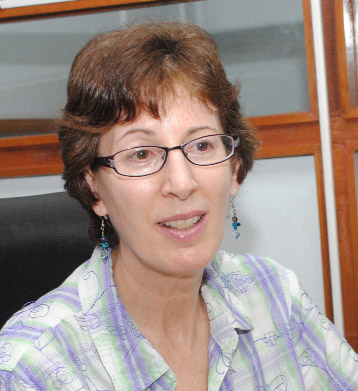A US expert on compost production and solid waste disposal, who is here to work with local farmers on maximising the transformation of backyard waste into useful manure, has told Stabroek Business that understanding the value of backyard waste can contribute to the creation of more efficient and safe regimes for the disposal of solid waste.
There are cases in which as much as 70 per cent of solid waste is actually material that can be transformed into compost, Rhonda Sherman, a North Carolina State University Extension Specialist in the Department of Biological and Agricultural Engineering told Stabroek Business in an interview on Wednesday.

Rhonda Sherman
Sherman said that while her assignment with the Partners of the Americas Farmer to Farmer programme seeks to provide kitchen and flower garden operators as well as farmers with practical information on the creation of compost, the initiative could also be seen as an exercise in solid waste disposal.
Alluding to the environmental dangers involved in the disposal of food waste in landfill sites Sherman noted that the methane gas emitted by rotting food waste can be far more lethal than carbon dioxide. “The emissions can be harmful to both water and air,” she added.
Sherman describes composting as “the controlled decomposition of organic materials such as grass clippings, leaves, yard trimmings, food scraps and recyclable paper,” much of which finds its way into landfill sites, into solid-like substance which can be used to enhance plant growth and provide benefits to both plants and soil. According to Sherman, composting promotes higher yield of crops, feeds diverse life into soils, makes soil easier to work, increases soil porosity, suppresses plant porosity, reduces the need for fertiliser and reduces the demand for water.
She said she was looking forward to working with kitchen gardeners and farmers in Guyana, since part of what she was hoping to demonstrate is how the conversion of food scraps and yard trimmings into compost saves on the purchase of soil amendments and fertilisers. “Homeowners who discard food waste are giving away their yard’s potential soil nutriments,” she said. An estimated 25 per cent of typical household waste comprises material that can be composted.
In addition to conducting training sessions with farmers, Sherman will also work with staff at the Guyana School of Agriculture (GSA) and the St Stanislaus College Farm (SSCF) in order to improve their compost production facilities, which produce compost from animal waste. Staff from other interested agencies, including the Guyana Livestock and Dairy Association and the University of Guyana, are also expected to meet Sherman.
Participants in seminars and practical instruction sessions conducted by Sherman will also gain insights into vermicomposting, a process that relies on earthworms and microcosms to help stabilise active organic materials and convert them into high-quality soil amendment and sources of plant nutrients. Sherman said vermicompost is highly valued among farmers in the US, fetching prices of up to around US$400 per square yard compared with US$30 per square yard for ordinary compost.




